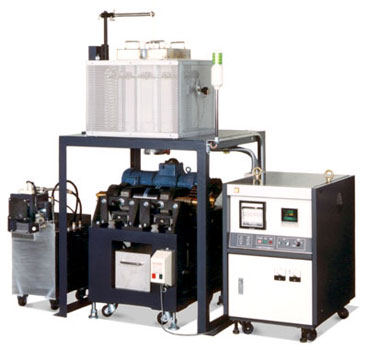Equipment Overview
This equipment is designed for glass melting.
Two types of furnaces are available: one with alumina fiberboard and the other with refractory materials. The one with alumina fiber board is equipped with a front door so that the melting crucible can be removed from the front. With the addition of optional equipment, a series of operations can be performed, such as sample stirring, glass flow out from the bottom of the furnace and pouring into the crusher, and mold pouring.

Features
- The alumina board specification is designed for excellent heat insulation and energy saving.
- With a wide range of options, the furnace can be used as a full-scale glass melting furnace, including glass spillage from the bottom of the furnace, stirring, and crushing.
- It is equipped with numerous safety designs for glass spills as well as electric furnaces.

option
- Sample stirring mechanism (degassing and defoaming of molten glass)
- Plunger mechanism (adjustment of glass outflow)
- shutter mechanism
- bottom-drawing mechanism
- One- or two-stage roller crushing mechanism
- Nozzle direct current mechanism (heating of the nozzle portion of the glass outlet)
- Automatic elevation of furnace bottom
Platinum-related options
- Molten crucible
- Melting crucible with long nozzle direct current
- mixing blade
- plunger
| Specifications NGV/SFV | ||||
| Model | Alumina board type | Refractory specification | ||
| NGV-1515D | NGV-2626F | SFV-1515D | SFV-2626F | |
| Furnace bottom dimensions W x D mm | 150×150 | 260×260 | 150×150 | 260×260 |
| Furnace inside dimensions W×H×D mm |
200×200×250 | 300×300×350 | 250×200×250 | 350×300×350 |
| Primary power supply | AC200V 1φ | |||
| Equipment capacity | 6.5KVA | 10.5KVA | 15KVA | 25KVA |
| Heater capacity | 5.5KW | 9KW | 12KW | 22KW |
| Max. temperature | 1600°C | 1550°C | ||
| Normal temperature | 1550°C | |||
| Temperature rise time | 90 minutes | 10 hours | ||
| Temperature distribution | ±5°C (no sample within the effective dimension) | |||
| Atmosphere | Atmosphere | |||
| Heating element | Molybdenum disilicide | |||
| Control method | PID control | |||
| Crucible | 100 mm dia. x 130 mm H | 130 x 150 mm dia. | 100 x H130 mm dia. | 130mm dia. x H150mm dia. |
| Furnace bottom lifting method | Manual, balance weight method | |||